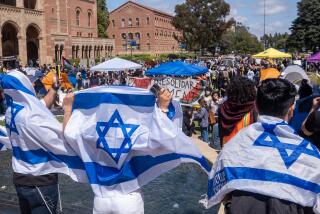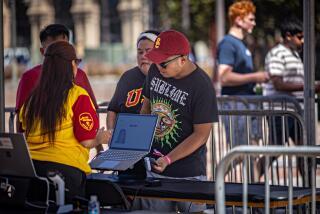When Right Goes Wrong : Faced With Racial Tension, Colleges Debate How Free Student Speech Should Be
- Share via
NEW YORK — Stung by an outbreak of bigotry on U.S. campuses, universities are taking steps to curb bias even if that means curbing free speech.
Civil rights advocates and civil libertarians, normally fast allies, have become adversaries as schools try to limit the views students can express and set penalties--including expulsion in certain cases--if those views slur female, black or other minority students.
Such sanctions have stirred a bitter, highly complex debate within higher education: Are anti-bias curbs likely to help, or hurt? Are college campuses so different from the rest of society that students’ First Amendment rights can be abridged? Are colleges abdicating their role as bastions of ideas, no matter how unpopular or even hateful? Finally, are anti-discrimination rules constitutional?
“I don’t believe freedom of speech on campus was designed to allow people to demean others on campus,” said Robert W. Ethridge, director of the equal opportunity program at Emory University in Atlanta, which adopted anti-bias rules last fall.
No Graffiti
“We just wanted to ensure that at a time when other universities were having problems that we made it clear that we wouldn’t tolerate graffiti on walls or comments in classes,” he said.
Many agree.
At Stanford University, where white students displayed a racist caricature of Beethoven near black students’ rooms last fall, minority students have been pressing the school to enact sanctions for the last year.
The University of Wisconsin, where a white fraternity held a mock slave auction last year, is considering anti-bias sanctions. The University of Oklahoma is considering tightening existing ones.
But last month a University of Michigan graduate student sued his school with the help of the American Civil Liberties Union, arguing that a recently enacted six-page anti-bias code is so broad it violates the First Amendment.
The student, identified only as John Doe in court papers, raised a hypothetical question: Do Michigan’s anti-bias rules bar a male student from saying in class that men outperform women in a particular field?
Michigan’s policy empowers the school to punish students guilty of “discriminatory conduct” in classroom buildings, libraries and university housing, but allows for more uninhibited speech in student publications and open-air campus forums.
It details behavior deemed discriminatory: Any act that “stigmatizes or victimizes an individual on the basis of race, ethnicity, religion, sex, sexual orientation, creed, national origin, ancestry, age, marital status, handicap or Vietnam-era veteran status.”
Even Michigan’s law school dean, Lee Bollinger, will not bet on who will prevail in the lawsuit. “The case law on what speech can be restricted is quite unclear,” he said.
The constitutional debate centers on the so-called “fighting words” doctrine. The U.S. Supreme Court coined the term in a 1942 ruling, Chaplinsky vs. New Hampshire, which stated that the First Amendment did not protect “insulting or ‘fighting’ words--those which by their very utterance inflict injury or tend to incite an immediate breach of the peace.”
The justices reiterated that view in Brandenburg vs. Ohio in 1969, and in Hess vs. Indiana in 1973.
The University of Wisconsin filed a brief last March to the state board of regents and cited the “fighting words” doctrine as buttressing its proposed anti-bias rules.
Students’ Rights Protected
But in other decisions, the Supreme Court has protected students’ rights--even the right to protest the draft with obscene signs.
In Tinker vs. Des Moines Public Schools in 1969, the court upheld students’ right to wear black armbands to protest the Vietnam War because the schools failed to show any evidence of serious disruption to the educational process.
But such apparently pro-free-speech rulings may also have sown the seeds for restrictions. By inference, the court indicated it might sustain free-speech curbs on campus, said Bollinger, if schools can show that certain speech leads to “serious disruption” of education.
A 1988 Supreme Court ruling involving a Hazelwood, Mo., principal who censored an article from his high school’s newspaper held that “a school need not tolerate student speech that is inconsistent with its basic educational mission even though the government could not censor similar speech outside the school.”
The Hazelwood ruling left unclear, however, whether that principle applied equally to colleges.
At worst, civil libertarians fear a future where free-speech restrictions could turn America’s campuses into “re-education camps” where only right-thinking people feel free to speak out.
“Does this mean you eventually ban a Louis Farrakhan, or a Meir Kahane, because they might upset some students?” asked Sheldon E. Steinbach, vice president and general counsel of the American Council on Education, the chief Washington lobby for higher education.
“Where are campuses going if they cannot discuss issues openly, even in a provocative manner? If you erect these kinds of potential punishments, aren’t you creating a chilling effect on free speech on campus? If I say the number of Jews killed during the Holocaust was overstated, am I baiting? Will I be judged post facto to have said something that is offensive?” Steinbach said.
Insults Commonplace
But the slights and insults minority students say are commonplace at all too many campuses convinced at least one civil liberties advocate that anti-bias restrictions are needed.
John Schwartz, a Dallas lawyer whose usual stock-in-trade is defending newspapers in First Amendment suits, wound up drafting the University of Michigan’s anti-bias rules last spring.
Schwartz said in an interview that his bedrock allegiance to absolute First Amendment rights was shaken after spending hours hearing black students at the Ann Arbor campus. They described, among other things, how they felt after racist jokes were broadcast over a university radio station last year.
“I think what tipped it for me was that I had been looking at the problem wrong,” he said. “I always thought that students ought to be able to shrug these (racial) comments off. But minority students are incredibly isolated on a mostly white campus. I was floored by the fact that minority students deal with this on a regular basis.”
To Bollinger and others, the essence of the debate gets down to what ideals universities ought to represent:
“Should the university be the place in society where there is ultimate protection of free speech, or is it a place where you want to preserve civility and discourse? Those are two very different models, both with strong appeals,” Bollinger said.
More to Read
Sign up for Essential California
The most important California stories and recommendations in your inbox every morning.
You may occasionally receive promotional content from the Los Angeles Times.










